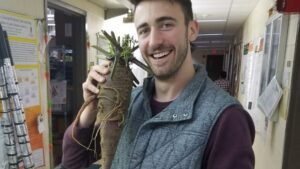From their beginnings S&W Seed has been focused on breeding alfalfa to thrive in tough conditions.
The “root” of S&W Seeds lies in non-dormant alfalfa breeding that started in the San Joaquin Valley in 1980.
“S&W was actually a large ranch that undertook alfalfa breeding in order to have varieties that would thrive in their saline soils,” shares Robin Newell, Vice President of Sales for S&W Seeds. “That Five Points (ranch) location is still the base of our non-dormant breeding program.”
Today the company’s breeding program still places tremendous focus on salt tolerance; breeding in soils with electrical conductivities (EC) as high as 115. For reference, growth and performance is restricted for most plants in the four to eight EC range.
Purchasing Pioneer’s conventional breeding program in 2014, S&W expanded rapidly into dormant varieties as well, adding two research stations in Nampa, Idaho and Arlington, Wis. “These two locations have all the major alfalfa pests and diseases present in North America, enabling S&W to easily breed and characterize varieties.
“If you are in those two areas, you will pretty much find everything that you are going to find of any consequence,” says Newell.
The Arlington breeding station is currently home to S&W’s pest characterization trials. Newell says that S&W inoculates seedlings and plants with an array of seven different diseases. Over the course of the following two years, the diseases are allowed to run their course and plants are evaluated on an individual basis as genetic parent material.
In addition, selection for nematode resistance is done in the greenhouse as well as in the field at the Nampa breeding location. Once the breeding and selections have been done, S&W characterizes each variety according to North American Alfalfa Improvement Conference (NAAIC) protocols.
S&W also utilizes an additional five to seven testing locations per year in other places throughout North America where characterization of potential new products is on-going.
With 120 experimental varieties and 30 commercial varieties under current evaluation, S&W compares experimental varieties to elite commercial check varieties, both elite S&W and competitive commercial checks. Comparisons include yield, forage quality and disease resistance according to NAAIC protocol, to produce industry leading varieties.
“Typically, our product characterization, especially for yield, takes three years for this perennial crop. It is a three-year process to characterize yield and agronomic traits so that you know what you want to advance to commercial status,” shares Newell.
To ensure seed purity beginning with the breeder seed stage, S&W starts all varieties in the greenhouse and then moves the seedlings to outside cages. This practice excludes outside pollinators and adventitious pollen from genetically modified plants. With one cage per variety, the production goal is somewhere between eight and ten kilos of seed produced per season, with hopes that the breeder seed will last the life of the variety. An additional two hundred grams of greenhouse produced breeder seed for each variety is also kept in cold storage in case additional seed needs to be produced to meet demand once a variety is released to market.
Coming full circle, the best dormant varieties from the northern located breeding program, are planted at the Five Points location for salt tolerance selection. With a well-established line of non-dormant salt tolerant product, S&W is pivoting to focus on greater salt tolerance within the dormant breeding program to better serve their entire customer base.












